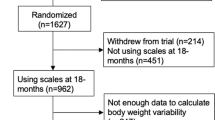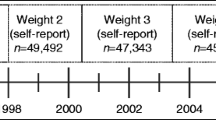Abstract
Recent studies have suggested that weight changes may be related to disease risk independent of weight status. A critical step in testing this assertion is the measurement of weight change and so-called “weight cycling”. However intuitive the concept of weight cycling may appear, research in this area is hampered by complex methodological issues. This article discusses various measures of nominal weight cycling, including the standard deviation, coefficient of variation, regression techniques, and cycles. A cycle is a sequence of a gain followed by a loss or vice versa. The various measures are compared in seven hypothetical cases created to illustrate their strengths and weaknesses. Superior performance of the cycles measure over the coefficient of variation, number of fluctuations, and simple regression methods is argued. The linkage of the cycles measure with the statistical theory of runs also provides a basis for testing the significance of weight fluctuations or other variables that may cycle, such as blood lipids, etc. The cycles measure and runs test provide a viable definition for identifying weight cycling and a tool for evaluating the critical amount of weight gained and/or lost in relationship to risk.
Similar content being viewed by others
References
Blair SN: Long-term benefits and adverse effects of weight loss: Data from two prospective epidemiological studies. NIH Obesity Technology Conference. 1992.
Sonne-Holm S, Sorensen TI, Jensen G, Schnohr P: Independent effects of weight change and attained body weight on prevalence of arterial hypertension in obese and non-obese men.British Medical Journal. 1989,299(6702):767–770.
Ashley FW, Kannel WB: Relation of weight change to changes in atherogenic traits: The Framingham Study.Journal of Chronic Diseases. 1974,27:103.
National Task Force on the Prevention and Treatment of Obesity: Weight cycling.Journal of the American Medical Association. 1994,272(15):1196–1202.
Archambault CM, Czyzewski D, Cordua y Cruz GD, Forety JP, Mariotto MJ: Effects of weight cycling in female rats.Physiology and Behavior. 1989,46(3):417–421.
Bene CR, Klesges RC, Burks M, O'Neil PM: The impact of weight cycling on energy balance and response to treatment.International Journal of Obesity. 1991,15(S3):45.
Brownell KD, Greenwood MRC, Stellar E, Shrager EE: The effects of repeated cycles of weight loss and regain in rats.Physiology and Behavior. 1986,38:459–464.
Blackburn GL, Wilson GT, Kanders BS, et al.: Weight cycling: The experience of human dieters.American Journal of Clinical Nutrition. 1989,49(S5):1105–1109.
Blanchard FA, Frost RO: Two factors of restraint: Concern for dieting and weight fluctuation.Behaviour Research and Therapy. 1893,21:259.
VanDale D, Saris WHM: Repetitive weight loss and weight regain: Effects on weight reduction, resting metabolic rate, and lipolytic activity before and after exercise and/or diet treatment.American Journal of Clinical Nutrition. 1989,49(3):409–416.
Graham B, Chang S, Lin D, Yakubu F, Hill JO: Effect of weight cycling on susceptibility to dietary obesity.American Journal of Physiology. 1990,259(6, Pt. 2):R1096–1102.
Gray DS, Fisler JS, Bray GA: Effects of repeated weight loss and regain on body composition in obese rats.American Journal of Clinical Nutrition. 1988,47(3):393–399.
Hill JO, Thacker S, Newby D, Sykes MN, Digirolamo M: Influence of food restriction coupled with weight cycling on carcass energy restoration during ad-libitum refeeding.International Journal of Obesity. 1988,12(6):547–555.
Holbrook TL, Barrett-Connor E, Wingard DL: The association of lifetime weight and weight control patterns with diabetes among men and women in an adult community.International Journal of Obesity. 1989,13:723–729.
Jebb SA, Goldberg GR, Coward WA, Murgatroyd PR, Prentice AM: Effects of weight cycling caused by intermittent dieting on metabolic rate and body composition in obese women.International Journal of Obesity. 1991,15(5):367–374.
Lissner L, Odell PM, D'Agostino RB, et al: Variability of body weight and health outcomes in the Framingham population.New England Journal of Medicine. 1991,324(26):1839–1844.
Lissner L, Andres R, Muller DC, Shimokata H: Body weight variability in men: Metabolic rate, health, and longevity.International Journal of Obesity. 1990,14(4):373–383.
Manore MM, Berry TE, Skinner JS, Carroll SS: Energy expenditure at rest and during exercise in non-obese female cyclical dieters and in non-dieting control subjects.American Journal of Clinical Nutrition. 1991,54:41–46.
Reed DR, Contreras RJ, Maggio C, Greenwood MR, Rodin J: Weight cycling in female rats increases dietary fat selection and adiposity.Physiology and Behavior. 1988,42(4):389–395.
Rodin J, Radke-Sharpe N, Rebuffe-Scrive M, Greenwood MRC: Weight cycling and fat distribution.International Journal of Obesity. 1990,14(4):303–310.
Saris WHM: Physiological aspects of exercise in weight cycling.American Journal of Clinical Nutrition. 1989,49:1099.
Schotte DE, Cohen E, Singh SP: Effects of weight cycling on metabolic control in male outpatients with non-insulin-dependent diabetes mellitus.Health Psychology. 1990,9(5):599–605.
Williamson PS, Levy BT: Long-term body weight fluctuation in an overweight population.International Journal of Obesity. 1988,12:579–583.
Kraemer HC, Berkowitz RI: Hammer LD: Methodological difficulties in studies of obesity. I. Measurement issues.Annals of Behavioral Medicine. 1990,12(3):112–118.
Kraemer HC, Berkowitz RI, Hammer LD: Methodological difficulties in studies of obesity. II. Design and analysis issues.Annals of Behavioral Medicine. 1990,12(3):119–124.
Kramer FM, Jeffery RW, Forster JL, Snell MK: Long-term followup of behavioral treatment for obesity: Patterns of weight regain among men and women.International Journal of Obesity. 1989,13(2):123–136.
Mood AM, Alexander M, Graybill FA:Introduction to the Theory of Statistics. New York: McGraw-Hill, 1963.
Siegel S:Nonparametric Statistics for the Behavioral Sciences. New York: McGraw-Hill, 1956.
Liang KY, Zeger SL:Longitudinal Data Analysis Using Generalized Linear Models. New York: Chapman Hall, 1986.
Zeger SL, Liang KY: Longitudinal data analysis for discrete and continuous outcomes.Biometrics. 1986,42:121–130.
Dunlop DD: Regression for longitudinal data: A bridge from least squares regression.American Statistician. 1994,48(4):299–303.
Harvey AC:Forecasting, Structural Time Series, and the Kalman Filter. Cambridge, England: Cambridge University Press, 1989.
Jones RH:Longitudinal Data with Serial Correlation: A State Space Approach. New York: Chapman Hall, 1993.
Author information
Authors and Affiliations
Additional information
Preparation of this manuscript was supported in part by NIH/NHLBI Grant #HL34589.
The authors would like to thank two anonymous reviewers for their efforts. Their comments contributed substantially to the revision of this paper.
About this article
Cite this article
Cutter, G., Jeor, S., Brunner, R. et al. Methodological issues in weight cycling. Ann Behav Med 18, 280–289 (1996). https://doi.org/10.1007/BF02895290
Issue Date:
DOI: https://doi.org/10.1007/BF02895290




